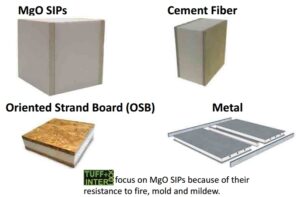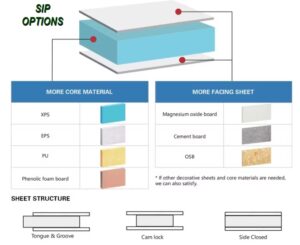SOLAR Off grid Electrics in TUFF+ house kits
Overview and architecture
Direct-DC house (minimal AC conversion): DC from panels/battery is distributed to DC-native loads (LED lighting, DC-DC appliances, electronics via built-in DC supplies). Very high efficiency for those loads; requires designing or replacing many household devices for DC compatibility.
DC microgrid with local AC conversion: PV → MPPT charge controller → DC battery bus (typically 48 V or higher) → inverter(s) required only where AC is needed.
DC is most common in off-grid and hybrid systems; reduces inverter runtime, improving efficiency and reliability.
Full AC house with PV/inverter: PV → inverter → house AC panel; conventional, easiest to integrate with existing appliances and grid, but incurs conversion losses.
Null
Key components for a DC-based house
PV array with MPPT charge controllers sized to house load and location.
Battery bank designed for DC-bus voltage (24 V, 48 V, 120 V DC, or higher). Lithium batteries recommended for energy density and cycle life.
DC distribution bus and breaker panel: DC-rated wires, connectors, fuses, breakers, and isolation switches. DC circuit protection must be rated for continuous DC arcs.
DC-DC converters to provide standard voltages for devices (5 V, 12 V, 24 V, 48 V, 54 V, 120 V DC) as needed.
Inverter(s) only if AC appliances or grid export/import are required.
Monitoring, grounding, surge protection, and safety devices designed for DC systems.
DC-native appliances or retrofits: DC LED lighting, air-source heat pumps with DC compressors, DC refrigerators, DC HVAC controllers, DC EV chargers (or AC charger with inverter).
Efficiency, cost, and practicality
-
Efficiency: Every AC/DC or DC/AC conversion adds loss. Eliminating unnecessary inverters and rectifiers improves system efficiency.
Cost and availability: DC-native household appliances are now available via the RV supply market. Battery and DC distribution costs vs. savings from reduced inverter hours should be evaluated.
Maintenance: DC systems require technicians familiar with DC safety and battery care.
SOLAR DC Summary
-
Running a house largely on SOLAR PV-generated DC is technically supportable and more efficient for DC-native loads, by selecting appropriate DC voltages, using DC-rated protection, and using DC built appliances.
A practical alternative for those who want standard 110V or 240V power is a DC battery bus with selective DC distribution plus an inverter for remaining AC loads;
Full DC-native houses are best in new-build scenarios where appliance choices and safety are planned from the start. That is what TUFF+ Houses supply.
More about SOLAR...
null
A SIP is a prefabricated building panel consisting of an insulative core sandwiched between two structural facings, used for walls, roofs, and floors, offering a strong, energy-efficient, and cost-effective construction system that does not require wooden studs.
-
Construction:SIPs are manufactured in a factory, ensuring quality control and precision, and then transported to the construction site for assembly.

The structural facings used by TUFF+ are normally MgO (Magnesium Oxide) boards, which have a long history and are explained below.
SIP Interior insulation can be a wide range of rigid insulative foams or materials including:
- Polyisocyanurate (polyiso) is a rigid, closed-cell foam insulation widely used in commercial and residential building construction, known for its high thermal efficiency, fire resistance, and moisture resistance.
- PU – Polyurethane
- Rockwool insulation, also known as stone wool or mineral wool, is a type of thermal insulation made from molten rock and recycled slag, offering excellent fire resistance, sound absorption, and durability.
- XPS insulation, or extruded polystyrene, is a rigid, closed-cell foam insulation material
- EPS or extruded Polystyrene is very commonly used as SIP insulation
SIP panels are pre-fabricated in a high tech
factory and shipped to the construction site, where they can be quickly assembled to form a tight, energy-efficient building envelope.
There are now many types of SIP – TUFF+ focuses on MgO structural sides because of their strength and benefits.


Practical implementation steps (Technical)
Audit loads: list appliances, power ratings, duty cycles; separate DC-friendly vs AC-only loads.
Choose DC-bus voltage that minimizes current while remaining safe and supported by equipment (48 V is a common starting point).
Size PV array and battery capacity to meet energy and autonomy goals.
Design DC distribution with DC-rated breakers, wiring, and surge protection.
Select DC-native appliances where cost-effective; use high-efficiency inverters only for unavoidable AC loads.
Install per local code with licensed professionals; include monitoring and maintenance plan.
Typical use cases
Off-grid homes: DC battery bus with inverter backup is common to minimize inverter runtime and maximize efficiency.
Net-zero or grid-tied homes: PV with inverter, battery backup, and selective DC distribution for critical loads (lighting, comms, pumps).
Tiny homes, RVs, boats: often run primarily on DC (12–48 V) because loads are smaller and designed for DC.
Remote telecom/industrial sites: use high-voltage DC buses routinely for efficiency.
Appliance compatibility and retrofitting
Electronics and LED lighting often accept DC internally; many devices such as phones and computers already use DC internally after AC-DC conversion.
Resistive loads (electric water heaters, ovens) work on DC but require DC-rated controls.
Motors and compressors: most AC motors need inverters; modern HVAC and refrigeration increasingly use brushless DC motors that can run efficiently on DC via appropriate drives.
Cooking, clothes dryers, and most major appliances are now available in DC – exceptions are more challenging to convert; often easier to keep them AC and use a small inverter or hybrid approach where necessary.
DC Safety and Implications
null
A SIP is a prefabricated building panel consisting of an insulative core sandwiched between two structural facings, used for walls, roofs, and floors, offering a strong, energy-efficient, and cost-effective construction system that does not require wooden studs.
-
Construction:SIPs are manufactured in a factory, ensuring quality control and precision, and then transported to the construction site for assembly.

The structural facings used by TUFF+ are normally MgO (Magnesium Oxide) boards, which have a long history and are explained below.
SIP Interior insulation can be a wide range of rigid insulative foams or materials including:
- Polyisocyanurate (polyiso) is a rigid, closed-cell foam insulation widely used in commercial and residential building construction, known for its high thermal efficiency, fire resistance, and moisture resistance.
- PU – Polyurethane
- Rockwool insulation, also known as stone wool or mineral wool, is a type of thermal insulation made from molten rock and recycled slag, offering excellent fire resistance, sound absorption, and durability.
- XPS insulation, or extruded polystyrene, is a rigid, closed-cell foam insulation material
- EPS or extruded Polystyrene is very commonly used as SIP insulation
SIP panels are pre-fabricated in a high tech
factory and shipped to the construction site, where they can be quickly assembled to form a tight, energy-efficient building envelope.
There are now many types of SIP – TUFF+ focuses on MgO structural sides because of their strength and benefits.


Key components for a DC-based house
PV array with MPPT charge controllers sized to house load and location.
Battery bank designed for DC-bus voltage (24 V, 48 V, 120 V DC, or higher). Lithium batteries recommended for energy density and cycle life.
DC distribution bus and breaker panel: DC-rated wires, connectors, fuses, breakers, and isolation switches. DC circuit protection must be rated for continuous DC arcs.
DC-DC converters to provide standard voltages for devices (5 V, 12 V, 24 V, 48 V, 54 V, 120 V DC) as needed.
Inverter(s) only if AC appliances or grid export/import are required.
Monitoring, grounding, surge protection, and safety devices designed for DC systems.
DC-native appliances or retrofits: DC LED lighting, air-source heat pumps with DC compressors, DC refrigerators, DC HVAC controllers, DC EV chargers (or AC charger with inverter).
Building Safety and code
DC behaves differently from AC: arcs are harder to quench, polarity needs careful management, and equipment must be DC-rated.
Electrical codes: NEC (US) and national/local codes regulate installation, battery storage, inverter interconnection, and DC bus implementations. Some jurisdictions require licensed electricians and inspections.
Isolation and emergency disconnects are mandatory. Firefighting and first-responder considerations must be addressed.
DC Voltage choices and implications
Low-voltage DC (12 V, 24 V): easy for small loads, high currents for household power — large copper conductors, higher losses; better for lighting, small appliances.
Medium-voltage DC (48–60 V): common compromise — safer (below extra-low/high risk thresholds varies by jurisdiction), lower current, common battery standard.
TUFF+ does not use High-voltage DC (120–400 V+): reduced currents and conductor size, which requires stricter insulation, safety, and DC-rated equipment; 120–380 VDC bus is used in advanced microgrids and telecom/industry.
Efficiency, cost, and practicality
RUNNING COSTS are low and can be ZERO!
If used in a tropical or sunny climate, the electricity generated and stored in a TUFF+ house battery block can be sufficient to run lights, appliances and air-conditioning all day and night.
TUFF+ converts the excess heat into cooling and running the house.
NOTE Efficiency: Every AC/DC or DC/AC conversion adds loss. Eliminating unnecessary inverters and rectifiers improves system efficiency. TUFF+ takes direct SOLAR DC electrical supply and using it without inefficient conversion.
Cost and availability: DC-native household appliances are now available via the RV supply market. Battery and DC distribution costs vs. savings from reduced inverter hours should be evaluated.
Maintenance: DC systems require technicians familiar with DC safety and battery care.

